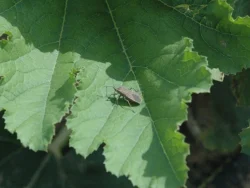Battling Squash Bugs in Your Garden

Gardening enthusiasts know that few things are as satisfying as growing your own vegetables. However, pests like squash bugs can quickly turn this joyful hobby into a frustrating challenge. If you’ve noticed your squash, zucchini, or pumpkins wilting and yellowing, these pests might be the culprits. Here’s how to identify, prevent, and manage squash bugs in your garden.
Identifying Squash Bugs
Squash bugs (Anasa tristis) are about 5/8 inch long, with a flat, shield-shaped body. They are typically dark brown or gray and emit a foul odor when crushed. Their eggs are reddish-brown, laid in clusters on the underside of leaves, and their nymphs are greenish to gray with black legs.
Signs of Infestation
- Wilting Plants: One of the first signs of a squash bug infestation is wilting leaves, especially during the heat of the day.
- Yellow Spots: Small yellow spots on leaves that eventually turn brown.
- Egg Clusters: Check the undersides of leaves for clusters of small, bronze-colored eggs.
- Visible Bugs: Adult and nymph squash bugs are often found hiding under leaves or near the base of the plant.
Prevention Tips
- Crop Rotation: Avoid planting squash in the same spot every year. Rotate crops to disrupt the life cycle of squash bugs.
- Companion Planting: Plant repellent plants like marigolds, nasturtiums, or tansy near your squash to deter pests.
- Clean Garden: Remove plant debris and weeds that can harbor squash bugs and other pests.
- Early Planting: Plant squash as early as possible. Older plants are more resistant to squash bug damage.
Management Strategies
- Handpicking: Regularly inspect plants and remove squash bugs by hand. Drop them into a bucket of soapy water to kill them.
- Neem Oil: Apply neem oil to infested plants. It acts as a repellent and disrupts the life cycle of the bugs.
- Diatomaceous Earth: Sprinkle diatomaceous earth around the base of your plants. This natural powder dehydrates and kills squash bugs.
- Row Covers: Use floating row covers to protect young plants, but remove them when flowers appear to allow pollination.
- Trap Crops: Plant a small section of your garden with a crop that attracts squash bugs, then destroy the infested plants.
Natural Predators
Encourage beneficial insects like tachinid flies, parasitic wasps, and ground beetles in your garden. These natural predators can help keep squash bug populations in check.
End of Season Cleanup
At the end of the growing season, remove and destroy all squash plant debris. This reduces the number of overwintering sites for adult squash bugs and helps minimize infestations in the following year.
By staying vigilant and employing a combination of these strategies, you can protect your garden from the detrimental effects of squash bugs and enjoy a bountiful harvest. Happy gardening! 🌱🌼
Feel free to share your own tips and experiences with squash bugs in the comments below!